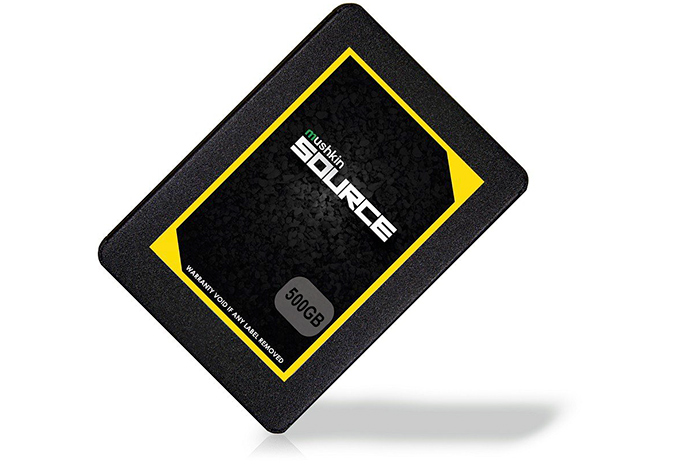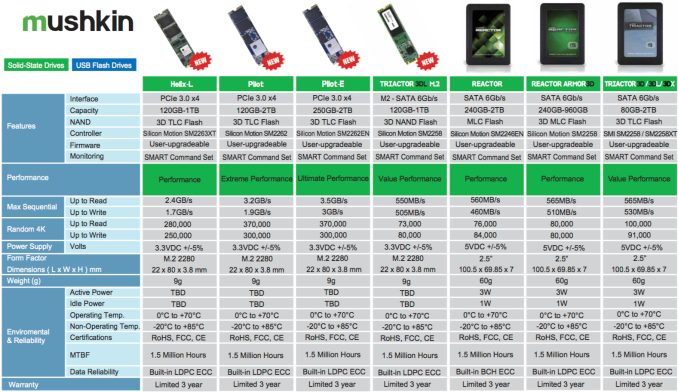Mushkin Launches Source SSDs: 3D TLC NAND, SATA, from $39 to $110
by Anton Shilov on March 30, 2018 2:00 PM EST
Mushkin has announced its new family of affordable SSDs primarily aimed at users who would like to upgrade their PCs featuring HDDs. The company’s Source drives use inexpensive 3D TLC NAND memory as well as a proven controller from Silicon Motion, allowing the company to start pricing at $39.
Mushkin’s Source family of SSDs includes three models featuring 120 GB, 250 GB, and 500 GB capacities. Mushkin says that 1 TB model will be included into the lineup at a later date, but does not elaborate. The drives come in a 2.5-inch/7mm form-factor and use a SATA interface, making them straightforward upgrades for existing desktops and mainstream laptops that use DFF storage devices. Muskin also plans to ship a M.2-2280 version of the Source family for ultra-thin notebooks sometimes in April. Mushkin’s Source drives are based on Silicon Motion’s SM2258XT controllers and 3D TLC NAND from an unnamed supplier, a combination that is frequently used by various SSD makers for their entry-level models these days.
On paper, the performance of Mushkin’s Source drives is comparable to other inexpensive SATA SSDs: up to 560 MB/s sequential write speed and up to 520 MB/s sequential write speed. As for random speeds, the manufacturer declares up to 75K 4K read IOPS as well as up to 81K write IOPS, which is somewhat lower than what we've seen in other 3D TLC-powered devices. Keep in mind that low-capacity SSDs usually perform slower than their higher-capacity counterparts, so for exact numbers check out the table below.
| Mushkin Source Specifications | ||||
| Capacity | 120 GB | 250 GB | 500 GB | 1 TB |
| Model Number | MKNSSDSR120GB | MKNSSDSR250GB | MKNSSDSR500GB | ? |
| Controller | Silicon Motion SM2258XT | |||
| NAND Flash | 3D TLC NAND | |||
| Sequential Read | 510 MB/s | 560 MB/s | ? | |
| Sequential Write | 440 MB/s | 515 MB/s | 520 MB/s | ? |
| Random Read IOPS | Up to 29K IOPS | Up to 54K IOPS | Up to 75K IOPS | ? |
| Random Write IOPS | Up to 79K IOPS | Up to 81K IOPS | Up to 81K IOPS | ? |
| Pseudo-SLC Caching | Supported | |||
| DRAM Buffer | No | |||
| TCG Opal Encryption | No | |||
| Power Management | DevSleep | |||
| Warranty | 3 years | |||
| MTBF | 1,500,000 hours | |||
| MSRP | $39 | $63 | $110 | ? |
The Source family of SSDs from Mushkin is the company’s fourth series of drives based on various types of 3D TLC NAND and Silicon Motion’s SM2258/SM2258XT controllers. Mushkin’s lineup already includes Triactor 3D, 3DL, and 3DX products, featuring capacity points ranging between 80 GB and 2 TB. It is noteworthy that based on the numbers from Mushkin’s product catalogue, its Triactor-series drives are faster when compared to the Source drives, but real-world performance of such SSDs isn't likely to be dramatically different.
All Mushkin Source SSDs are rated for 1.5 million hours MTBF and come with a three-year limited warranty. The drives are available now in the U.S.: the cheapest 120 GB version is priced at $39, the 250 GB flavor costs $63, whereas the 500 GB SKU is sold for $110. Keeping in mind that formally the Source family of SSDs are Mushkin’s lowest-end drives, expect their pricing to be very flexible.
Related Reading:
Source: Mushkin











42 Comments
View All Comments
hojnikb - Sunday, April 1, 2018 - link
It's not just about DRAM bom. DRAM also needs more complex pcb, more pins on the controller itself...Samus - Monday, April 2, 2018 - link
True, a lot of the cost savings of a DRAMless controller are carried over to the PCB, which almost always lack tracing and provisions for DRAM. The cost of a DRAM controller vs a DRAMless controller themselves are negligible, though. For example, the SM2263XT (DRAMless) Phison E8 (DRAMless) NVMe controllers are $14/ea and $16/ea respectively in 1000 unit quantities, and the SM2263 (DRAM supported) is $16 in 1000 unit quantities, all according to ADATA (Silicon Motion) and MyDigitalSSD (Phison) and interestingly the E8 sells for the same price as the E7.Considering a $2 price premium for the DRAM supported controller, it's safe to say the majority of the costs would be the DRAM itself, not so much the controller or the ~$1 in PCB screening costs.
ಬುಲ್ವಿಂಕಲ್ ಜೆ ಮೂಸ್ - Friday, March 30, 2018 - link
Up to 560 MB/s sequential write speed and up to 520 MB/s sequential write speed.MDD1963 - Friday, March 30, 2018 - link
Time for the SATA 4 spec of 1200 MB/sec...' way too many drives being bottlenecked by SATA3's old-school 6 Gb/sec....ಬುಲ್ವಿಂಕಲ್ ಜೆ ಮೂಸ್ - Friday, March 30, 2018 - link
I was indicating the errorwrite speed vs write speed
DanNeely - Friday, March 30, 2018 - link
SATA itself is full of API/protocol level bottlenecks for high speed SSDs, which is why the NVME interface was created to run over PCIe for high speed SSDs.SATA3 is likely to remain the final SATA standard ever because other than the DRAM cache it's nowhere near being able to bottleneck an HDD and consumer HDDs will likely have faded away before the become fast enough to be a problem.
bug77 - Friday, March 30, 2018 - link
NVMe itself is just a protocol, it doesn't care what physical connection it is being sent over. SATA drives could talk NVMe (instead of AHCI). But then we'd need more expensive hosts.ಬುಲ್ವಿಂಕಲ್ ಜೆ ಮೂಸ್ - Friday, March 30, 2018 - link
A 3 second boot to Windows is fast enough, so all I really need is IDE over SATA 2AHCI is not for SSD's anyway
Wait.....what?
Now I'm off topic as well
See what you did?
jabber - Saturday, March 31, 2018 - link
Yeah I don't care about the protocol just upgrade it to keep pace and keep using the SATA port connections that have served us well the past 15 years.Then we can dump all these new connections that are gaining popularity like continental drift.
Flunk - Saturday, March 31, 2018 - link
They tried that, they needed 3 different connectors for the PCI-E signal. It was called SATA Express and it was such a failure that no one ever made a drive that supported it, despite it being on basically every motherboard at the time.The last thing we need right now is a new connector, U.2 already exists and is electrically compatible with M.2. A new SATA version that requires new cables with more contacts would just muddy the water further and the multi-cable idea was already failed.